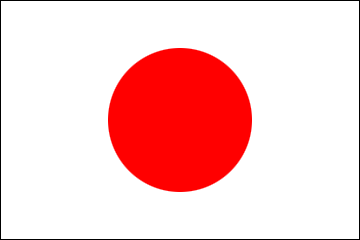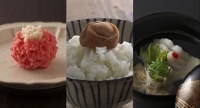Japanese Kitchen
2020/9/30
As we have already featured recipes from Honshu, Hokkaido and Kyushu, for the ninth recipe in our Japanese Kitchen series we take our first visit to the smallest of Japan's four main islands, Shikoku. In particular we travel to Ehime Prefecture, situated in the northwestern part of Shikoku. With a warm and mild climate, the prefecture is surrounded by Seto Inland Sea, often referred to as the Aegean Sea of the Orient.
Tai-meshi (Rice with Sea bream)
by Masahiro Kurokawa
originally published in October 2014
Imabari is the second biggest city in Ehime prefecture with a population of around 160,000 people, located on the coast facing the Setonaikai (Seto Inland Sea). For tourism, the Nishiseto Expressway (often called the Shimanami Kaidō), the bridge that connects the islands stretching all the way to Hiroshima prefecture, is particularly famous.
Despite being a country bumpkin, born and bred in a small town, I came to the comparatively huge City of London in 1999 and for some reason it suited me and I have now been living here for over 15 years. I have met a lot of English people through my hobbies, and whether the similarity is due to Japan and the UK both being island countries I’m not sure, but there are quite a number of things about Brits, such as their way of thinking and sense of humour, that Japanese can relate to and I am fortunate to be surrounded by some great friends.
However, I do often miss my home-town! Imabari is a place with both mountains and sea, it is also home to quite a peculiar food culture, particularly popular are; tai-meshi (a rice dish with fresh sea bream from the Setonaikai), yakitori, senzanki (soy-marinated deep-fried chicken), and a B-class gourmet rice dish with roast pork and egg. Luckily for me, my mother was an excellent cook and from childhood I have been surrounded with delicious food.
My mother’s tai-meshi was particularly exquisite and I would love to be able to share the recipe with you here but the details are a trade secret and so instead I will share a recipe from the Imabari region’s food popularisation association. If you have a chance to visit Imabari, please try eating at a local Japanese restaurant or get the lunch box from the Imabari train station where you can try authentic tai-meshi for yourselves. In the meantime - why not try to make it at home?!
originally published in October 2014
Imabari is the second biggest city in Ehime prefecture with a population of around 160,000 people, located on the coast facing the Setonaikai (Seto Inland Sea). For tourism, the Nishiseto Expressway (often called the Shimanami Kaidō), the bridge that connects the islands stretching all the way to Hiroshima prefecture, is particularly famous.
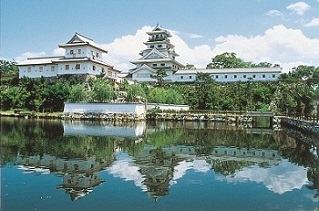 |
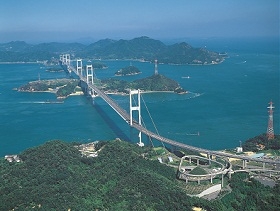 |
| Imabari Castle (Photograph courtesy of Imabari City) | Nishiseto Expressway (Photograph courtesy of Imabari City) |
Despite being a country bumpkin, born and bred in a small town, I came to the comparatively huge City of London in 1999 and for some reason it suited me and I have now been living here for over 15 years. I have met a lot of English people through my hobbies, and whether the similarity is due to Japan and the UK both being island countries I’m not sure, but there are quite a number of things about Brits, such as their way of thinking and sense of humour, that Japanese can relate to and I am fortunate to be surrounded by some great friends.
However, I do often miss my home-town! Imabari is a place with both mountains and sea, it is also home to quite a peculiar food culture, particularly popular are; tai-meshi (a rice dish with fresh sea bream from the Setonaikai), yakitori, senzanki (soy-marinated deep-fried chicken), and a B-class gourmet rice dish with roast pork and egg. Luckily for me, my mother was an excellent cook and from childhood I have been surrounded with delicious food.
My mother’s tai-meshi was particularly exquisite and I would love to be able to share the recipe with you here but the details are a trade secret and so instead I will share a recipe from the Imabari region’s food popularisation association. If you have a chance to visit Imabari, please try eating at a local Japanese restaurant or get the lunch box from the Imabari train station where you can try authentic tai-meshi for yourselves. In the meantime - why not try to make it at home?!
Tai-meshi recipe
Ingredients
Instructions
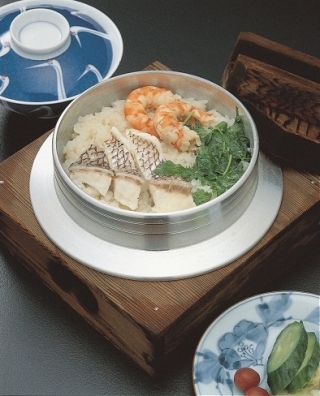 1. Remove the scale and innards of the sea bream and give the fish a quick rise in water.
1. Remove the scale and innards of the sea bream and give the fish a quick rise in water.
2. Place the rice in a large bowl and gently wash with water. When the water becomes cloudy, drain the rice. Repeat several times until the water is almost clear.
3. Drain the rice in a colander and leave it for about 30-60 minutes.
4. Place the rice and water in a pot. Add the salt, soy sauce and sake, and then the water. Place the kombu and whole sea bream on top and close the lid, making sure it is on tight. (You can cut the sea bream into slices if you prefer.)
5. Put on a high heat and bring to the boil.
6. When it boils, continue to cook for 12-15 minutes on a low heat (so that the rice doesn't burn) until all the water has evapourated.
7. Turn off the heat and let the rice sit for another 10 minutes.
8. When the rice is cooked, remove the konbu and sea bream. Place the sea bream on a plate and flake its meat into small pieces.
9. Return the flaked sea bream into the pot of rice and mix well.
10. Your tai-meshi is ready to serve!
Photograph: Imabari tai-meshi courtesy of Imabari City
- Sea Bream: (1 whole fish, small)
- Sushi rice: 3 cups
- Water: 3 cups
- Light soy sauce: 3 tablespoons
- Salt: 1 teaspoon
- Sake (Japanese rice wine) 1.5 tablespoons
- Kombu* (edible kelp) 1 piece (5cm square)
Instructions
 1. Remove the scale and innards of the sea bream and give the fish a quick rise in water.
1. Remove the scale and innards of the sea bream and give the fish a quick rise in water.2. Place the rice in a large bowl and gently wash with water. When the water becomes cloudy, drain the rice. Repeat several times until the water is almost clear.
3. Drain the rice in a colander and leave it for about 30-60 minutes.
4. Place the rice and water in a pot. Add the salt, soy sauce and sake, and then the water. Place the kombu and whole sea bream on top and close the lid, making sure it is on tight. (You can cut the sea bream into slices if you prefer.)
5. Put on a high heat and bring to the boil.
6. When it boils, continue to cook for 12-15 minutes on a low heat (so that the rice doesn't burn) until all the water has evapourated.
7. Turn off the heat and let the rice sit for another 10 minutes.
8. When the rice is cooked, remove the konbu and sea bream. Place the sea bream on a plate and flake its meat into small pieces.
9. Return the flaked sea bream into the pot of rice and mix well.
10. Your tai-meshi is ready to serve!
Photograph: Imabari tai-meshi courtesy of Imabari City
